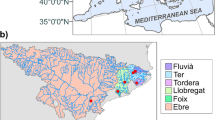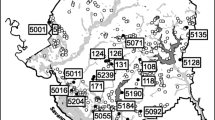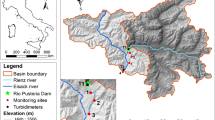Abstract
The headwaters of karst rivers experience considerable hydrological variability, including spates and streambed drying. Extreme summer flooding on the River Lathkill (Derbyshire, UK) provided the opportunity to examine the invertebrate community response to unseasonal spate flows, flow recession and, at temporary sites, streambed drying. Invertebrates were sampled at sites with differing flow permanence regimes during and after the spates. Following streambed drying at temporary sites, dewatered surface sediments were investigated as a refugium for aquatic invertebrates. Experimental rehydration of these dewatered sediments was conducted to promote development of desiccation-tolerant life stages. At perennial sites, spate flows reduced invertebrate abundance and diversity, whilst at temporary sites, flow reactivation facilitated rapid colonisation of the surface channel by a limited number of invertebrate taxa. Following streambed drying, 38 taxa were recorded from the dewatered and rehydrated sediments, with Oligochaeta being the most abundant taxon and Chironomidae (Diptera) the most diverse. Experimental rehydration of dewatered sediments revealed the presence of additional taxa, including Stenophylax sp. (Trichoptera: Limnephilidae) and Nemoura sp. (Plecoptera: Nemouridae). The influence of flow permanence on invertebrate community composition was apparent despite the aseasonal high-magnitude flood events. Flow permanence was also critical in determining the community response to the spate flows. Following streambed drying at temporary sites, the surficial sediments overlying the karstic bedrock functioned as an effective refugium for several taxa. The development of aquatic insects following experimental rehydration indicated that these taxa survived in dewatered sediments as desiccation-resistant eggs.




Similar content being viewed by others
References
Berrie, A. D., 1992. The chalk-stream environment. Hydrobiologia 248: 3–9.
Bonada, N., M. Rieradevell, N. Prat & V. H. Resh, 2006. Benthic macroinvertebrate assemblages and macrohabitat connectivity in Mediterranean-climate streams of northern California. Journal of the North American Benthological Society 25: 32–43.
Boulton, A. J., 1989. Over-summering refuges of aquatic macroinvertebrates in two intermittent streams in central Victoria. Transactions of the Royal Society of Southern Australia 113: 22–34.
Boulton, A. J., 2003. Parallels and contrasts in the effects of drought on stream macroinvertebrate assemblages. Freshwater Biology 48: 1173–1185.
Boulton, A. J. & E. H. Stanley, 1995. Hyporheic processes during flooding and drying in a Sonoran Desert stream. II. Faunal dynamics. Archiv für Hydrobiologie 134: 27–52.
Boulton, A. J., C. G. Peterson, N. B. Grimm & S. G. Fisher, 1992. Stability of an aquatic macroinvertebrate community in a multiyear hydrologic disturbance regime. Ecology 73: 2192–2207. doi: 10.2307/1941467
Byrne, R. A. & R. F. McMahon, 1994. Behavioural and physiological responses to emersion in freshwater bivalves. American Zoologist 34: 194–204.
Chakona, A., C. Phiri, C. H. D. Magadza & L. Brendonck, 2008. The influence of habitat structure and flow permanence on macroinvertebrate assemblages in temporary rivers in northwestern Zimbabwe. Hydrobiologia 607: 199–209.
Clinton, S. M., N. B. Grimm & S. G. Fisher, 1996. Response of a hyporheic invertebrate assemblage to drying disturbance in a desert stream. Journal of the North American Benthological Society 15: 700–712.
Costil, K., G. B. J. Dussart & J. Daguzan, 2001. Biodiversity of aquatic gastropods in the Mont St-Michel basin (France) in relation to salinity and drying of habitats. Biodiversity and Conservation 10: 1–18.
Dahms, H., 1995. Dormancy in the Copepoda—an overview. Hydrobiologia 306: 199–211.
Datry, T., S. T. Larned & M. R. Scarsbrook, 2007. Responses of hyporheic invertebrate assemblages to large scale variation in flow permanence and surface-subsurface exchange. Freshwater Biology 52: 1452–1462.
Dole-Olivier, M.-J. & P. Marmonier, 1992. Effects of spates on the vertical distribution of the interstitial community. Hydrobiologia 230: 49–61.
Erman, N. A. & D. C. Erman, 1995. Spring permanence, Trichoptera species richness, and the role of drought. Journal of the Kansas Entomological Society 68: 50–64.
Fenoglio, S., T. Bo & G. Bosi, 2006. Deep interstitial habitat as a refuge for Agabus paludosus (Fabricus) (Coleoptera: Dytiscidae) during summer droughts. The Coleoptersists Bulletin 60: 37–41.
Fritz, K. M. & W. K. Dodds, 2004. Resistance and resilience of macroinvertebrate assemblages to drying and flood in a tallgrass prairie stream system. Hydrobiologia 527: 99–112.
Furse, M. T., J. F. Wright, P. D. Armitage & D. Moss, 1981. An appraisal of pond-net samples for biological monitoring of lotic macroinvertebrates. Water Research 15: 679–689.
Gagneur, J. & C. Chaoui-Boudghane, 1991. Sur le rôle du milieu hyporhéique pendant l’assèchement des oueds de l’Ouest Algérien. Stygologia 6: 77–89.
Gunn, J., P. Hardwick & P. J. Wood, 2000. The invertebrate community of the Peak-Speedwell cave system, Derbyshire, England—pressures and considerations for conservation management. Aquatic Conservation: Marine and Freshwater Ecosystems 10: 353–369.
Hughes, D. A., 2005. Hydrological issues associated with the determination of environmental water requirements of ephemeral rivers. River Research and Applications 21: 899–908.
Humphries, P. & D. S. Baldwin, 2003. Drought and aquatic ecosystems: an introduction. Freshwater Biology 48: 1141–1146.
Kramer, C. Y., 1956. Extension of multiple range tests to group means with unequal numbers of replicators. Biometrics 12: 309–310.
Lake, P. S., 2000. Disturbance, patchiness and diversity in streams. Journal of the North American Benthological Society 19: 573–592.
Lancaster, J. & A. G. Hildrew, 1993. Flow refugia and the microdistribution of lotic macroinvertebrates. Journal of the North American Benthological Society 12: 385–393.
Ladle, M. & J. A. B. Bass, 1981. The ecology of a small chalk stream and its responses to drying during drought conditions. Archiv für Hydrobiologie 90: 448–466.
Landin, J., 1980. Habitats, life histories, migration and dispersal by flight of two water-beetles Helophorus brevipalpis and H. strigifrons (Hydrophilidae). Holartic Ecology 3: 190–201.
Lindegaard, C., K. P. Brodersen, P. Wiberg-Larsen & J. Skriver, 1998. Multivariate analyses of macrofaunal communities in Danish springs and springbrooks. In Botosaneanu, L. (ed.), Studies in Crenobiology: The Biology of Springs and Springbrooks. Backhuys Publishers, Leiden: 201–210.
Lytle, D. A., 2000. Biotic and abiotic effects of flash flooding in a montane desert stream. Archiv für Hydrobiologie 150: 85–100.
Lytle, D. A. & N. L. Poff, 2004. Adaptation to natural flow regimes. Trends in Ecology & Evolution 19: 94–100.
Marsh, T., 2008. A hydrological overview of the summer 2007 floods in England and Wales. Weather 63: 274–279.
McLachlan, A., 1983. Life-history tactics of rain-pool dwellers. Journal of Animal Ecology 52: 545–561.
Meyer, A. & E. I. Meyer, 2000. Discharge regime and the effect of drying on macroinvertebrate communities in a temporary karst stream in East Westphalia (Germany). Aquatic Science 62: 216–231.
Meyer, A. M., E. I. Meyer & C. Meyer, 2003. Lotic communities of two small temporary karstic stream systems (East Westphalia, Germany) along a longitudinal gradient of hydrological intermittency. Limnologica 33: 271–279.
Monk, W. A., P. J. Wood, D. M. Hannah & D. A. Wilson, 2008. Macroinvertebrate community response to inter-annual and regional river flow regime dynamics. River Research and Applications 24: 988–1001.
Montalto, L. & M. Marchese, 2005. Cyst formation in Tubificidae (Naidinae) and Opistocystidae (Annelida, Oligochaeta) as an adaptive strategy for drought tolerance in fluvial wetlands of the Paraná River, Argentina. Wetlands 25: 488–494.
Olsen, D. A. & C. R. Townsend, 2005. Flood effects on invertebrates, sediments and particulate organic matter in the hyporheic zone of a gravel-bed stream. Freshwater Biology 50: 839–853.
Pisces Conservation Ltd., 2002. Species Diversity and Richness—3.03. Pisces Conservation Ltd., Lymington, UK.
Pipan, T., 2005. Epikarst—a Promising Habitat: Copepod fauna, its Diversity and Ecology: a Case Study from Slovenia (Europe). ZRC Publishing, Zalozba.
Rundle, S. D., A. Foggo, V. Choiseul & D. T. Bilton, 2002. Are distribution patterns linked to dispersal mechanism? An investigation using pond invertebrate assemblages. Freshwater Biology 47: 1571–1581.
Salavert, V., C. Zamora-Muñoz, M. Ruiz-Rodríguez, A. Fernández-Cortés & J. J. Soler, 2008. Climatic conditions, diapause and migration in a troglophile caddisfly. Freshwater Biology 53: 1606–1617.
Shackley, S., J. Kersey, R. Wilby & P. Fleming, 2001. Changing by Degrees: The Potential Impacts of Climate Change in the East Midlands. Ashgate Publishing Ltd, UK, Farnham.
Smith, H. & P. J. Wood, 2002. Flow permanence and macroinvertebrate community variability in limestone spring systems. Hydrobiologia 487: 45–58.
Smith, H., P. J. Wood & J. Gunn, 2003. The influence of habitat structure and flow permanence on invertebrate communities in karst spring systems. Hydrobiologia 510: 53–66.
Stanley, E. H., D. L. Buschmann, A. J. Boulton, N. B. Grimm & S. G. Fisher, 1994. Invertebrate resistance and resilience to intermittency in a desert stream. American Midland Naturalist 131: 288–300.
Suren, A. M. & I. G. Jowett, 2006. Effects of floods versus low flows on invertebrates in a New Zealand gravel-bed river. Freshwater Biology 51: 2207–2227.
ter Braak, C. J. F. & P. Šmilauer, 2002. CANOCO Reference manual and CanoDraw for Windows User’s guide: Software for Canonical Community Ordination (version 4.5). Microcomputer Power, Ithaca, NY, USA: 500 pp.
Trouve, S., L. Degen, F. Renaud & J. Goudet, 2003. Evolutionary implications of a high selfing rate in the freshwater snail Lymnaea truncatula. Evolution 57: 2303–2314.
Tukey, J. W., 1949. Comparing individual means in the analysis of variance. Biometrics 5: 99–114.
Vinogradova, E. B., 2007. Diapause in aquatic insects, with emphasis on mosquitoes. In Alekseev, V. R., B. T. De Stasio & J. J. Gilbert (eds), Diapause in Aquatic Invertebrates: Theory and Human Use. Springer, Dordrecht, The Netherlands.
Way, C. M., D. J. Hornbach & A. J. Burky, 1980. Comparative life history tactics of the Sphaeriid clam, Musculium partumeium (Say), from a permanent and a temporary pond. American Midland Naturalist 104: 319–327.
Williams, D. D., 1996. Environmental constraints in temporary fresh waters and their consequences for the insect fauna. Journal of the North American Benthological Society 15: 634–650.
Williams, D. D., 2006. The Biology of Temporary Waters. Oxford University Press, Oxford.
Wood, P. J., J. Gunn, H. Smith & A. Abas-Kutty, 2005. Flow permanence and macroinvertebrate community diversity within groundwater dominated headwater streams and springs. Hydrobiologia 545: 55–64.
Wright, J. F., 1981. A 9-year study of the life-cycle of Ephemera danica Müll (Ephemeridae, Ephemeroptera) in the River Lambourn, England. Ecological Entomology 6: 321–331.
Wright, J. F., P. D. Hiley, D. A. Cooling, A. C. Cameron, M. E. Wigham & A. D. Berrie, 1984. The invertebrate fauna of a small chalk stream in Berkshire, England, and the effect of intermittent flow. Archiv für Hydrobiologie 99: 176–199.
Acknowledgements
AMG acknowledges the support of a Nuffield Foundation Undergraduate Research Science Bursary (URB\34138) entitled: ‘The survival of macroinvertebrate fauna within ephemeral streams’, under the supervision of PJW to undertake part of this research. We would like to thank Natural England for access to the site and particularly Philip Bowler for support and encouragement throughout the research. Hydrological data (precipitation and river discharge) were kindly provided by the Environment Agency of England and Wales, and by the Limestone Research Group at the University of Birmingham. We thank the associated editor, and two anonymous reviewers for their constructive comments on an earlier version of this manuscript.
Author information
Authors and Affiliations
Corresponding author
Additional information
Handling editor: Sonja Stendera
Electronic supplementary material
Below is the link to the electronic supplementary material.
Rights and permissions
About this article
Cite this article
Stubbington, R., Greenwood, A.M., Wood, P.J. et al. The response of perennial and temporary headwater stream invertebrate communities to hydrological extremes. Hydrobiologia 630, 299–312 (2009). https://doi.org/10.1007/s10750-009-9823-8
Received:
Revised:
Accepted:
Published:
Issue Date:
DOI: https://doi.org/10.1007/s10750-009-9823-8




